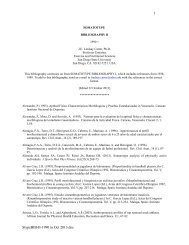THE HEATH-CARTER ANTHROPOMETRIC ... - Somatotype.org
THE HEATH-CARTER ANTHROPOMETRIC ... - Somatotype.org
THE HEATH-CARTER ANTHROPOMETRIC ... - Somatotype.org
You also want an ePaper? Increase the reach of your titles
YUMPU automatically turns print PDFs into web optimized ePapers that Google loves.
<strong>Somatotype</strong> Instruction Manual 5<br />
recording form and average or median values calculated before transfer to the rating form. A blank<br />
rating form is provided in Figure 3.<br />
A. The Heath-Carter <strong>Somatotype</strong> Rating Form<br />
(1) Record pertinent identification data in top section of rating form.<br />
Endomorphy rating (steps 2-5)<br />
(2) Record the measurements for each of the four skinfolds.<br />
(3) Sum the triceps, subscapular, and supraspinale skinfolds; record the sum in the box opposite SUM3<br />
SKINFOLDS. Correct for height by multiplying this sum by (170.18/height in cm).<br />
(4) Circle the closest value in the SUM3 SKINFOLDS table to the right. The table is read vertically<br />
from low to high in columns and horizontally from left to right in rows. "Lower limit" and "upper limit" on<br />
the rows provide exact boundaries for each column. These values are circled only when SUM3<br />
SKINFOLDS are within 1 mm of the limit. In most cases circle the value in the row "midpoint".<br />
(5) In the row for endomorphy circle the value directly under the column for the value circled in number<br />
(4) above.<br />
Mesomorphy rating (steps 6-10)<br />
(6) Record height and breadths of humerus and femur in the appropriate boxes. Make the corrections<br />
for skinfolds before recording girths of biceps and calf. (Skinfold correction: Convert triceps skinfold to<br />
cm by dividing by 10. Subtract converted triceps skinfold from the biceps girth. Convert calf skinfold to<br />
cm, subtract from calf girth.)<br />
(7) In the height row directly to the right of the recorded value, circle the height value nearest to the<br />
measured height of the subject. (Note: Regard the height row as a continuous scale.)<br />
(8) For each bone breadth and girth circle the number nearest the measured value in the appropriate<br />
row. (Note: Circle the lower value if the measurement falls midway between two values. This<br />
conservative procedure is used because the largest girths and breadths are recorded.)<br />
(9) Deal only with columns, not numerical values for the two procedures below. Find the average<br />
deviation of the circled values for breadths and girths from the circled value in the height column as<br />
follows:<br />
(a) Column deviations to the right of the height column are positive deviations. Deviations to the<br />
left are negative deviations. (Circled values directly under the height column have deviations of<br />
zero and are ignored.)<br />
(b) Calculate the algebraic sum of the ± deviations (D). Use this formula: mesomorphy = (D/8)<br />
+ 4.0. Round the obtained value of mesomorphy to the nearest one-half (½) rating unit.<br />
(10) In the row for mesomorphy circle the closest value for mesomorphy obtained in number 9 above.<br />
(If the point is exactly midway between two rating points, circle the value closest to 4 in the row. This<br />
conservative regression toward 4 guards against spuriously extreme ratings.)<br />
Ectomorphy rating (steps 11-14).<br />
(11) Record weight (kg).




